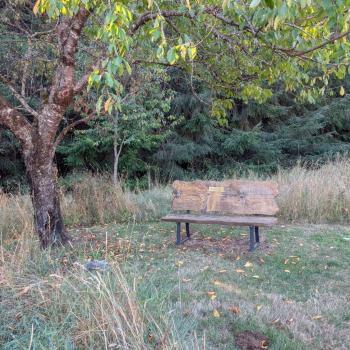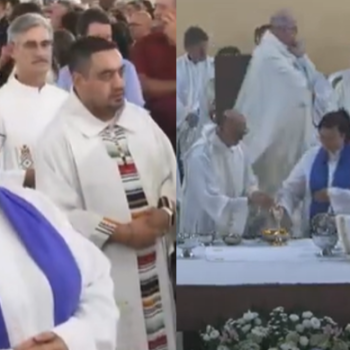However, there are even further and far easier options than that. I know a number of polytheists who have built temples in their own homes—whether houses or apartments—and who have dedicated entire rooms to nothing but semi-permanent sacred space. This is something that is relatively easy to do, so long as one has the room to do so in one's primary residence.
I've been in some so-called temple spaces in private homes that have had nothing special in particular about them. But, before and after PantheaCon, I was in a space known as the Temple of Nyx (or the Temple of Night), and it was one of the most amazing places I've been to in my entire life in terms of actualizing a numinous presence in every aspect of the physical environment that can be controlled. Technically, it is not even a "room of its own," but instead is a section of a larger room that has had a wall (covered in tapestries and furs) installed around it, with a door, a raised floor, and various internal features. But, it works, and works extremely well.
Why? There are procedures for entering and leaving the Temple that must be followed by those who are using it. There are things stored inside the Temple, and I actually slept in the Temple on two nights—both of those matters are things which ancient polytheistic temples also did on a regular basis. But the dedicated and sanctified space of the Temple made it inviting to enter and pleasant to simply be in. It isn't a community center or a meeting hall; it's a holy place.
And, when it came time for ritual actions on my part to occur in the Temple, it was like standing in an amphitheater . . . with a megaphone . . . turned up full blast projecting into a sound system...!?! Using a dedicated polytheistic space for a dedicated polytheistic ritual made a gigantic difference to which rented rooms could not compare.
I've been to many sacred sites around the world in my travels during the last two decades. I've been to both Stonehenge (in the inner circle) and Newgrange, Emain Macha and Tara. I've been to a number of smaller stone circles, wedge tombs, and other megalithic sites in Britain and Ireland as well. I've been to sacred wells in Ireland and Britain, and to the ruins of Roman forts and temples along Hadrian's Wall. I've been to churches as large and as continuously functioning as York Minster in northern England—the largest Gothic cathedral in Britain—and as small and ruined as Labbamolagga (whose founding saint is a form of the god Lug!) in north County Cork, Ireland. I've been to holy and numinous places in nature, both obvious and unexpected. And I've been to the Tsubaki Grand Shrine of America in Granite Falls, Washington on many occasions—the only Jinja-Honcho recognized Shinto Shrine in the continental United States.
While many of these places were wonderful, memorable, and worth visiting for a variety of reasons, the energetic presence and cultivated spiritual environment of almost all pales in comparison to the Tsubaki Grand Shrine. Every time I go there for a ceremony, I enjoy myself, but I also get the definite feeling of the presence of the kami, which I can describe as a kind of cold, white, fresh-feeling energy that often becomes more prominent at particular parts of the ceremony. It is a kind of undifferentiated, impersonal energy, which energizes and refreshes one's ki. Because this divine presence is actively cultivated and tended to on a daily basis, the entire Shrine grounds has an atmosphere that is entirely consonant with that energy.
Being in the Temple of Night, however, was another sort of experience altogether. Not only was there energy and divine presence, but there was also very strong personality to the presence and the energy. It is personality that didn't come from all of the wonderful accoutrements, physical fittings, and the material atmosphere of the Temple, or from the people who created it and tended it on a daily basis—although, that is a large part of it. It is a personality in presence that comes from the deities who inhabit the space, under Nyx's hospitality. (And, note, it is not just Greek-derived deities who inhabit the space!)
So, my biggest concern in creating modern Pagan temple spaces is not so much whether or not they can be built (although that is a major concern), or whether building them will create community, or sustain community (which is also a very large concern, particularly if ground is being broken, figuratively or literally, in relation to such a temple). My biggest concern is whether or not the most important element of the entire matter—the gods who are honored there—end up coming, and feeling welcome and honored enough to take up the temple as a permanent home. That doesn't always have as much to do with what statues of them one gets, or how nice the carpet is, or if the zoning laws account for a religious building, or whether the community is paying regularly for upkeep—and that is both unfortunate, but also the simple reality of dealing with deities in a polytheistic context.
We build temporary sacred spaces which deities attend on a regular basis. The biggest question with temples is: if we build them, not only will the gods come to them, but will they decide to stay there for as long as it is possible? If that question is not at the heart of any discussion of whether or not temples are viable options, then almost everything else becomes moot, in my opinion.





